The Tudors Historical Inaccuracies Season 2
Jump to navigation
Jump to search

◄ Back home: <a href="/" target="_self">The Tudors Fan Wiki</a> See also: The Tudors Depictions Throughout History | The Tudors Photos | The Tudors 100 Reasons to Watch
< Back home: <a href="/" target="_self">The Tudors Fan Wiki</a>
See also: The Tudors Depictions Throughout History | The Tudors Photos | The Tudors 100 Reasons to Watch | The Tudors Links & Resources 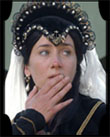 FACT OR FICTION? History buffs! Have you sniffed out a few historical inaccuracies within The Tudors drama? Whether minuscule or huge, catalogue them here to see how the show sizes up against British history. (Brief descriptions please - for more lengthy in-depth history see characters profiles and other individual pages on Site Map) Season 2
| |
| |
| According to The Tudors | According to History | |
| |  Princess Mary Tudor has dark hair. Princess Mary Tudor has dark hair. | Mary's natural hair color was actually red like her father and mother, although she dyed her hair various colors during her adult years. |
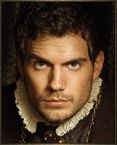 Charles Brandon marries his 17 year-old ward, Catherine Brooke. Episode # 2:1 Charles Brandon marries his 17 year-old ward, Catherine Brooke. Episode # 2:1 | 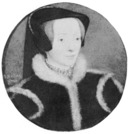 Charles married his fourth wife Catherine Willoughby in 1534 (after Anne Boleyn's coronation), she was 15 at the time and Charles was 50. Charles probably married Catherine for her income of 15,000 ducats a year rather than out of love. Charles married his fourth wife Catherine Willoughby in 1534 (after Anne Boleyn's coronation), she was 15 at the time and Charles was 50. Charles probably married Catherine for her income of 15,000 ducats a year rather than out of love. | |
 Margaret, Sir Thomas More's eldest daughter, is depicted as a teenager in season one, and in her mid to early twenties in season two. Margaret, Sir Thomas More's eldest daughter, is depicted as a teenager in season one, and in her mid to early twenties in season two. | Margaret More (1505 - 1544) would have been in her late twenties during the time season one took place, and in her early thirties in season two. Additionally, Margaret was married to William Roper in 1521. | |
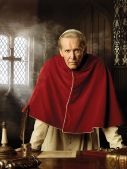 Pope Paul III has been elected at the beginning of season two, and suggests the benefit of arranging the assassination of Anne Boleyn. Episode: 2.1 Pope Paul III has been elected at the beginning of season two, and suggests the benefit of arranging the assassination of Anne Boleyn. Episode: 2.1 | Pope Paul III was elected October 13, 1534 (after Anne Boleyn's coronation). There no historical basis for an assassination attempt against Anne Boleyn, much less one arranged by the Vatican or Charles V (though they certainly wouldn't have been sorry to see her go if it had happened that way). | |
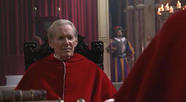 Pope Paul III doesn't have a beard. Pope Paul III doesn't have a beard. |  After the sack of Rome in 1527, the next twenty four popes, from Pope Clement VII to Pope Innocent XII, wore beards to commemorate the six months that the Pope was imprisoned by Charles V. | |
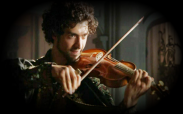 Mark Smeaton plays a violin solo in episode 2, season 2 Mark Smeaton plays a violin solo in episode 2, season 2 | The actor (David Alpay) was not using a strong enough bow to produce much sound- baroque and pre-baroque instruments required a fast-pulled bow, as well as slightly stronger pressure, for higher dynamics. The actor was also not using the right fingerings. Nor the accurate shoulder placement for pre-baroque playing. | |
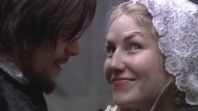 Thomas Cranmer smuggles his "illegal wife" to England from Germany in a wooden crate. It is implied that the wife in the box on The Tudors is Cranmer's first wife, and he calls her "Katarina." Thomas Cranmer smuggles his "illegal wife" to England from Germany in a wooden crate. It is implied that the wife in the box on The Tudors is Cranmer's first wife, and he calls her "Katarina."Episode #2:03 | In his book "Thomas Cranmer: A Life" Historian Diarmaid MacCulloch raises, only to dismiss, the rumor that she was kept in a box. However he does say that Margaret, the second Mrs. Cranmer, must have lived in England so secretly that even her husband's most bitter opponents never learned of her existence. Perhaps the box was used as symbolism of that fact? Cranmer's first wife was English and her name was Joan. He married her after graduating from Cambridge and she died a year later. | |
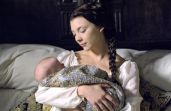 Henry reacts to the birth of his daughter Elizabeth by saying to Anne, "You and I are both young and with God's grace, boys will follow." Henry reacts to the birth of his daughter Elizabeth by saying to Anne, "You and I are both young and with God's grace, boys will follow." Episode# 2.03 | Henry made a similar statement to the Venetian ambassador Giustiniani upon the birth of Princess Mary on February 18, 1516. In 1516, Henry was 24 years old and Queen Katherine was 30, they were both not yet past childbearing years. However, when Elizabeth was born September 7, 1533, Henry was pushing 42. Despite being older than his second wife, it is unlikely Henry would have said "you and I are BOTH young" to Anne Boleyn. | |
The king visits Lady Eleanor Luke and they make love in Episode 2.3 Whilst Anne is cradling Elizabeth in her arms in the other chamber, Henry is embracing Lady Eleanor Luke, which makes it happen around September 1533, after Elizabeth's birth.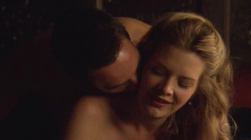 The show also portrays that Henry had many affairs behind Anne's back, particularly the scene where Anne is lying in bed crying over thoughts of her husband with many naked women. | Lady Eleanor Luke is a fictional character. However, there were reports of a mysterious lady from 1534 that was reported by Chapuys to be Henry's mistress. No historian has been able to identify her and she was not Mary (Madge Sheldon) Shelton who caught the wandering eye of King Henry VIII in <a class="external" href="http://en.wikipedia.org/wiki/1535" rel="nofollow" target="_blank" title="1535">1535</a>. Their affair lasted for around six months, beginning in February 1533 The truth is that Henry had only two reported mistresses while married to Anne Boleyn. As stated above they were a mystery woman in 1534 and Mary Shelton, Anne's cousin in 1535. He later met Jane Seymour who had been lady in waiting to Katherine of Aragon and returned home to Wolf Hall, where she supposedly caught Henry's eye in 1536, not long before Anne's accusations and charges began. | |
<a href="/page/George+Boleyn" target="_self">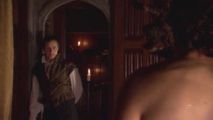 </a>George Boleyn's affair with Mark Smeaton, which starts in Episode 2.3, when Mark mentions that Anne is not as "beautiful as her brother", hinting at his lust for the Boleyn brother. In episode 2.4, Mark Smeaton plays the violin, shirtless, and asks George Boleyn whether he plays. The answer is "all the time" and then Mark unbuttons George's shirt. </a>George Boleyn's affair with Mark Smeaton, which starts in Episode 2.3, when Mark mentions that Anne is not as "beautiful as her brother", hinting at his lust for the Boleyn brother. In episode 2.4, Mark Smeaton plays the violin, shirtless, and asks George Boleyn whether he plays. The answer is "all the time" and then Mark unbuttons George's shirt. | According to historians Eric Ives and David Starkey, there is not one "scintilla" of evidence to support the theory of George Boleyn being homosexual, bi-sexual or involved in a sexual relationship with any of the courtiers surrounding Anne Boleyn at her time of reign. George was known to be a bit of a "flirt" and even considered a "ladies' man". He was chivalrous and sweet, unlike the portrayal in the show. One historian, Retha Warnicke, has posed the theory that George was homosexual - along with the other men executed with Anne but she has no proof to back it up. | |
 Pope Paul III tells William Brereton that he has created the order of the Jesuits and asks Brereton to join. Episode # 2:4 Pope Paul III tells William Brereton that he has created the order of the Jesuits and asks Brereton to join. Episode # 2:4 | The Society of Jesus, or the Jesuits, were not created until September 1540 when Pope Paul III signed the papal bull Regimini militantis Ecclesiae. The original order was limited to 60 members with Ignatius of Loyola elected as the Superior General. Brereton was never a member and was dead before the society was even formed. | |
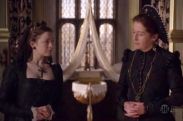 Lady Margaret Bryan introduces herself to Lady Mary Tudor as if they had never met before. Episode # 2.4 Lady Margaret Bryan introduces herself to Lady Mary Tudor as if they had never met before. Episode # 2.4 | Lady Margaret Bryan was well acquainted with Lady Mary since she served Mary before as her governess. In fact, Lady Bryan helped raise all three of Henry VIII's royal children and was awarded the title of Baroness for her troubles. | |
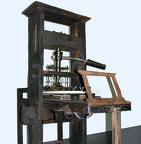 Thomas Cromwell shows a wide eyed George Boleyn a machine "It's called a printing press, my lord. And it will change the world." Thomas Cromwell shows a wide eyed George Boleyn a machine "It's called a printing press, my lord. And it will change the world."Episode #2:6 | The printing press had been introduced to England by William Caxton in 1476. Since then, hundreds of printed books and documents had been circulating throughout England. George Boleyn would have been aware of what a printing press was and its significance to the Reformation, even if he hadn't seen one before. | |
Henry Norris speaks to the King about his interest in Madge Sheldon Episode # 2:6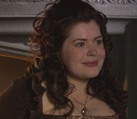 Madge is also shown giving testimony against Anne Boleyn and her brother along with Nan Saville and Jane Boleyn. | <a class="external" href="http://upload.wikimedia.org/wikipedia/en/4/45/Maryshelton.jpg" rel="nofollow" target="_blank"> </a>In actual fact, it was Francis Weston who was rumoured to be having an affair with Mary Shelton (called Madge in the series). She is often confused with her sister Margaret "Madge" Shelton, but it is now clear that it was Mary who was Henry's mistress and who was rumored to become his fourth wife. The confusion arose from the label "Marg Shelton", where the y looked like a g - a common confusion in sixteenth-century writing. </a>In actual fact, it was Francis Weston who was rumoured to be having an affair with Mary Shelton (called Madge in the series). She is often confused with her sister Margaret "Madge" Shelton, but it is now clear that it was Mary who was Henry's mistress and who was rumored to become his fourth wife. The confusion arose from the label "Marg Shelton", where the y looked like a g - a common confusion in sixteenth-century writing.Madge Sheldon was not one of the ladies who testified against her cousin...nor Nan Saville. The ladies that gave evidence were Margery Horsman and Elizabeth Browne, Lady Worcester (sister of Sir Anthony Browne, a staunch supporter of Princess Mary Tudor, sister in law of William Brereton & step sister of Sir William Fitzwilliam who was heavily involved in the Boleyn enquiries).Jane Boleyn nee Parker, Lady Rochford did not give evidence at Anne's trial but Cromwell used some of her testimony and he used the deathbed testimony of Bridget Wiltshire, Lady Wingfield who died c.1534. | |
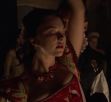 When Anne is having a party in her room, Henry comes in and tells the musicians to play a Volta. When Anne is having a party in her room, Henry comes in and tells the musicians to play a Volta.Episode #2:6 | The musicians actually play the piece "Como Poden Per Sas Culpas", written by King Alfonso X of Spain, out of a collection of songs in honor of the Blessed Virgin Mary. The reformer king and queen are actually dancing to a song in honor of a Catholic saint. While the tune isn't anachronistic (King Alfonso lived in the 13th century), it is not a Volta melody. | |
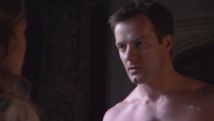 George Boleyn rapes his wife, Jane Boleyn on their wedding night. George Boleyn rapes his wife, Jane Boleyn on their wedding night.Episode 2.06 | The rape scene is complete fiction, as there is no known historical record of it. Marital rape was not recognised during this period, which means there would be no record. However, George did not have a reputation for being a violent man. In fact, quite the opposite - he was a very popular member of court. The animosity between he and his wife was more than likely grounded in their very different religious beliefs. | |
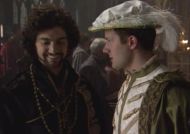 The series depicts George Boleyn & Mark Smeaton snickering together at George's wedding to Jane Parker about him marrying "a girl" - a heavy-handed nod to their homosexual affair. The series depicts George Boleyn & Mark Smeaton snickering together at George's wedding to Jane Parker about him marrying "a girl" - a heavy-handed nod to their homosexual affair.Episode: 2.06 | George married Jane Parker c. 1524/5 before the King began courting his sister, which would make Mark Smeaton around 12 years old at the time and hardly in a high court position. George was approximately 12 years older than Mark. | |
| Thomas Cromwell sponsors plays to be performed that serve as propaganda to justify the King's Reformation. When asked who is the play's author, Cromwell credits "a Mr. Bale". The King, Anne, Thomas, and George Boleyn all watch and enjoy the play. Episode: 2.06 | John Bale was a prolific Protestant propagandist who did write plays produced by Thomas Cromwell. The background given in the series about Bale is also accurate - he was a former member of the Carmelites who converted to Protestantism. The inaccuracy lies in the play which is adapted from Bale's "Kynge Johan" which was probably written in 1538, too late for the three Boleyns to have been alive, together and seeing it being performed. | |
 Anne appears in yellow to celebrate Katherine's death, while a somber Henry in black is at her side. Episode #2:7 Anne appears in yellow to celebrate Katherine's death, while a somber Henry in black is at her side. Episode #2:7 | It was historically recorded that both Anne and Henry wore yellow, top to toe, after hearing of the former Queen's demise in church that Sunday. Note: Yellow is the color of mourning in Spain which is appropriate for the death of a Spanish daughter. Note: Yellow is a color of cheer and joy in England. Additional note: There is controversy regarding whether yellow was actually the color of mourning in Spain at the time. | |
<a href="/page/Thomas+Wyatt" target="_self"> Thomas Wyatt</a> discovers Elizabeth Darrell, a lady in waiting to Katherine of Aragon, has hanged herself after her mistress's death. Thomas Wyatt</a> discovers Elizabeth Darrell, a lady in waiting to Katherine of Aragon, has hanged herself after her mistress's death.Episode # 2:7 | In actuality, Elizabeth Darrell bore Wyatt three sons and outlived him. Also, as a devout Catholic, she would not have committed suicide because it would be a cardinal sin and one for which she would be forever damned according to her beliefs. | |
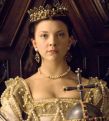 Anne Boleyn holds the Sovereign Orb at her Coronation. Anne Boleyn holds the Sovereign Orb at her Coronation.Episode # 2:3 | The Sovereign Orb didn't exist then. It was made in the reign of Charles II. | |
[[William Brereton|  William Brereton]] attempts to assassinate Anne Boleyn in her wedding parade William Brereton]] attempts to assassinate Anne Boleyn in her wedding parade | This is complete fiction. There is no evidence that neither Brereton nor anyone else was commissioned by the Pope to assassinate Anne. | |
<a href="/page/Henry+Norris" target="_self"> Henry Norris</a> is shown as being the jouster who unseats Henry and causes him to be injured. Episode #2:7 Henry Norris</a> is shown as being the jouster who unseats Henry and causes him to be injured. Episode #2:7 | There is no record of who or even if there was another jouster involved. All that was said was that his horse fell and crushed him. | |
| Pope Paul III relates to King Francis that he is preparing to excommunicate Henry VIII. Episode: 2.08 | It was Pope Clement VII who issued a bull of excommunication for the English King in 1533, but the bull wasn't enforced until five years later under Pope Paul III. | |
| At various banquet scenes, the song, "Mr. Beveridge's Maggot" is heard being played. Episodes # 2:8, 2:9 | The song was composed in the late 17th century, over one hundred years after the events in "The Tudors" take place. | |
 Princess Elizabeth Tudor joins her "papa" and "mama" in the gardens, but the child is too old to be the real princess at this time. The child actress was at least 4. Princess Elizabeth Tudor joins her "papa" and "mama" in the gardens, but the child is too old to be the real princess at this time. The child actress was at least 4. Episode # 2: | Elizabeth was born in September 1533, and "mama" was beheaded in May 1536, so she was 2-1/2 when her mother was executed. See Also: Age and the Tudors. | |
| William Brereton is shown as confessing his adultery with Anne Boleyn Episode #2:8 | Mark Smeaton was the only one of the 5 men accused of adultery with the queen who confessed, and it is thought that was only due to the fact that he was tortured because he was a commoner. The only comment made by any of the other men regarding the charges was by Henry Norris, who said that he believed that Queen Anne was innocent and that he would '...die a thousand deaths rather than ruin an innocent person.' NOTE: Henry Norris claimed he had been tricked into a confession of some sort, and he recanted whatever he had confessed to. | |
 Jane Seymour is played by beautiful actress, Anita Briem. Jane Seymour is played by beautiful actress, Anita Briem. | 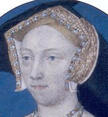 Historical records (and paintings) consistently refer to Jane as plain, and many sources believe that the only reason Henry VIII was interested in her at all was because she provided such a stark contrast to Anne Boleyn. Historical records (and paintings) consistently refer to Jane as plain, and many sources believe that the only reason Henry VIII was interested in her at all was because she provided such a stark contrast to Anne Boleyn. | |
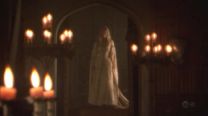 Anita Briem tells us in an interview that she plays Jane Seymour as an eighteen year old girl. Anita Briem tells us in an interview that she plays Jane Seymour as an eighteen year old girl. | Jane Seymour was in her mid twenties when she first caught the eye of the King. Her birth year is debated as 1508/1509, making her 26 at youngest when she first met Henry. | |
| Episode # 2: 8 Mark Smeaton says how pretty Jane Seymour is to Thomas Wyatt and that she is new to court. | Jane Seymour had been at court for more than 6 years, having been a lady in waiting to Queen Katherine of Aragon before she attended to Queen Anne Boleyn. | |
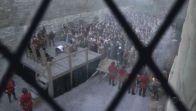 There were only 4 men arrested & executed for adultery with Queen Anne. Episode # 2:9 There were only 4 men arrested & executed for adultery with Queen Anne. Episode # 2:9 | There were 5 men. Sir Francis Weston was completely left out as a character in the series. | |
 Thomas Cranmer was present at Anne Boleyn's execution, & instigates the crowd to kneel when she did to be beheaded. Episode # 2:10 Thomas Cranmer was present at Anne Boleyn's execution, & instigates the crowd to kneel when she did to be beheaded. Episode # 2:10 | He was walking with Alexander Ales when it happened and is reported to have sat down and wept when the hour came. The Tudors is not the only series to have Cranmer present at Anne's execution. In the mini-series "Henry VIII", Cranmer is on the scaffold with Anne, and falls to his knees and crosses himself when she is beheaded. It is the opinion of this Wiki member that these scenes are meant to represent Cranmer's (apparent) belief in Anne's innocence, as doing a cutaway to show Cranmer's grief after the execution would be anti-climactic. | |
 Anne Boleyn is executed in public. Episode #2:10 Anne Boleyn is executed in public. Episode #2:10 | Some sources describe the execution as private. NOTE TO POSTING: The term "private" is relative (see entry on Glossary page.) Eric Ives estimates around 1,000 spectators, including the Lord mayor & aldermen of London & 'certain of the best' craftsmen of London, Charles Brandon, Henry Fitzroy & Thomas Cromwell. | |
| King Henry is at Lord Seymour's home at the time of Anne Boleyn's execution Episode #2:10 | In fact, the King was out hunting and some sources say that Thomas Boleyn could have been with him (!) | |
| Thomas Boleyn is incarcerated at the Tower and walks free on the day of his daughter's execution. Episode #2.10 | Thomas Boleyn was not incarcerated, only disgraced. This was due to his willingness to openly condemn his children Anne and George. | |
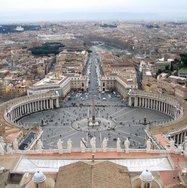 St Peter's Square in Rome already has the famous Bernini Courtyard and Columns: St Peter's Square in Rome already has the famous Bernini Courtyard and Columns: | The Square did not exist in that form in the 1520's and 1530's. In fact, it was totally redesigned in a typically Baroque style by Bernini between 1652 and 1667. Open courtyards which integrate directly with their surroundings via a large artery are typical of the 17th and 18th centuries. Other examples of that approach - Versailles and its gardens (also mid 17th century) and Christopher Wren's London (designs for the post fire reconstruction, 1667 onwards). | |
 Anne Boleyn miscarries a deformed fetus, fueling the fire of suspicion that she is a witch and unfaithful to the king. Anne Boleyn miscarries a deformed fetus, fueling the fire of suspicion that she is a witch and unfaithful to the king. | Historian Eric Ives and Alison Weir dismiss this theory as having no basis. It has been pointed out that in all of the accustions against Anne, a deformed fetus was never mentioned, not even during Mary's reign,when "substantial anti-Boleyn material appeared." As a deformed fetus would have been considered evidence of witchcraft or other evil-doing, it would have made no sense to hide it. (The Life and Death of Anne Boleyn, by Eric Ives.) | |
 Anne Boleyn made a speech to Cranmer during her confession, including such statements that she never was unfaithful to her lord and husband, she would gladly have died many deaths to deliver the men unjustly condemned; she did not show her husband sufficient humility; she had jealous thoughts about her husband; and she was not making these statements to prolong her life, as God had taught her how to die. Anne Boleyn made a speech to Cranmer during her confession, including such statements that she never was unfaithful to her lord and husband, she would gladly have died many deaths to deliver the men unjustly condemned; she did not show her husband sufficient humility; she had jealous thoughts about her husband; and she was not making these statements to prolong her life, as God had taught her how to die. | This is actually the speech Anne Boleyn made at her trial after she was found guilty of treason and adultery. However, it was reported that Anne Boleyn declared her innocence to Cranmer during her last confession before her death. | |
| Sir Thomas Boleyn, Earl of Wiltshire and George Boleyn, Viscount Rochford conspired to murder Bishop Fisher. | It is unknown who was behind the poisoning of Fisher and his friends. | |
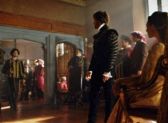 Thomas Wyatt introduces Mark Smeaton to Anne Boleyn. Thomas Wyatt introduces Mark Smeaton to Anne Boleyn. | There is no evidence that Thomas Wyatt and Mark Smeaton knew each other by that time. It was Anne Boleyn who noticed the young Mark Smeaton in Henry's household and his talents and began favouring him. | |
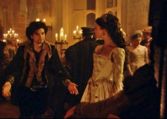 Later on, Anne Boleyn introduces Mark Smeaton to the King. Later on, Anne Boleyn introduces Mark Smeaton to the King. | Mark Smeaton had been in the King's Household for years and was one of Henry's favourites before Anne noticed him. | |
| In Episode 2.10 Princess Mary asks Chapuys " Is it done? Is the harlot dead?" | Mary was so well bought up that "she knew no foul or unclean speech" according to Jane Dormer. It appears that even during Anne's lifetime she never heard the word "*****" which makes it unlikely that she even knew the word "harlot". From a story related by Alison Weir in "Children of England" Mary apparently never heard the word "*****" until she was in her forties and even then didn't know what it meant; "She was so bred that she knew no foul or unclean speech and when her lord father heard about it he would not believe it and ordered a courtier to use swear words during a masque. While the ladies blushed and giggled Mary was at a loss to know what the joke was. When she was Queen, Lord William Howard tickled the chin of one of Mary's maids saying "How art thou my pretty *****?" quite unaware that Mary was listening, later while helping the Queen dress Mary exclaimed "God a mercy my pretty *****!" The maid begged the Queen not to call her that as "a ***** is a wicked misgiving woman". Mary apologised and said she had never heard that word before and knew not what it meant." | |
◄ Back home: <a href="/" target="_self">The Tudors Fan Wiki</a> See also: The Tudors Depictions Throughout History | The Tudors Photos | The Tudors 100 Reasons to Watch